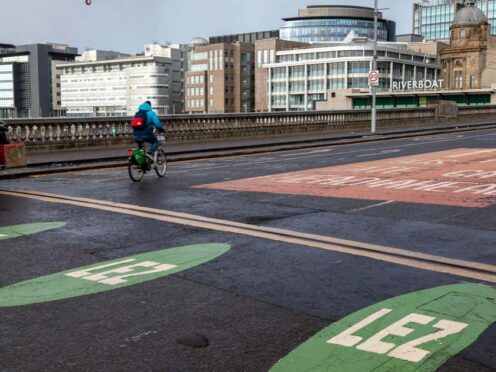
The number of Scots who support the rollout of low emission zones (LEZs) has grown since last year, a poll suggests.
LEZs are areas within cities where owners of older, heavily polluting vehicles including cars, buses, taxis and motorcycles are fined for driving in.
A recent survey of 1,000 Scots conducted by Opinion Matters found 60% support LEZs, up from 53% last year.
The March poll also shows 21% oppose LEZs, down from 23% in 2023.
The survey was commissioned by health charity Asthma + Lung UK Scotland, which has welcomed the introduction of LEZs in Aberdeen, Dundee, Edinburgh and Glasgow.
Gareth Brown, chairman of Healthy Air Scotland and policy and public affairs officer at Asthma + Lung UK Scotland, said: “Air pollution from cars contain dangerous toxins such as carbon monoxide, nitrogen dioxide and particulate matter.
“At a cost of £1.1 billion per year to Scotland, it is draining our resources, straining our health system and cutting short over 2,700 lives a year.
“With one in five Scots developing a lung condition like asthma and chronic obstructive pulmonary disease (COPD) in their lifetime, for them, air pollution can trigger life-threatening asthma attacks and flare-ups.

“Children are more susceptible to air pollution as their lungs are still growing, and they also breathe faster than adults. As they grow, toxic air can stunt the growth of their lungs, making them less resilient into adulthood and placing them at greater risk of lung disease in the future.
“We want to see politicians from all parties coming together to tackle air pollution and encourage behavioural change. With greater investment in public transport and active travel, and exemptions for the most vulnerable, we want to see our cities to be far healthier places, where people aren’t exposed to unhealthy air.
“Traffic reduction policies like LEZs are seen as the most effective tool, but we would like to see policies that go further, helping to clear up pollution hotspots throughout the country, not just in our four main cities.
“It is vitally important that we protect the lungs and health of our communities, no-one should be forced to breathe in toxic air.”
Transport Secretary Fiona Hyslop said: “It’s encouraging to see growing support for LEZs, which are designed to protect public health by improving air quality.
“Cities around the world have been implementing LEZs in response to continued scientific findings into the effects of air pollution caused predominantly by vehicle emissions.
“The support from public health charities such as Asthma + Lung UK is welcomed by the Scottish Government and local authorities – and they are right that LEZs cannot work in isolation.
“Beyond the full enforcement of Scotland’s LEZs by June 1, we’re continuing to invest over £2 billion a year on public transport, delivering ambitious policies such as free bus travel for the under-22s, the extension of the peak fares pilot for rail travel and continued investment in active travel to make walking, wheeling and cycling easier for more people.
“By encouraging a shift away from cars and towards sustainable transport, we make our city centres better places to live, work in and visit – while at the same time protecting public health and the climate.”

Enjoy the convenience of having The Sunday Post delivered as a digital ePaper straight to your smartphone, tablet or computer.
Subscribe for only £5.49 a month and enjoy all the benefits of the printed paper as a digital replica.
Subscribe